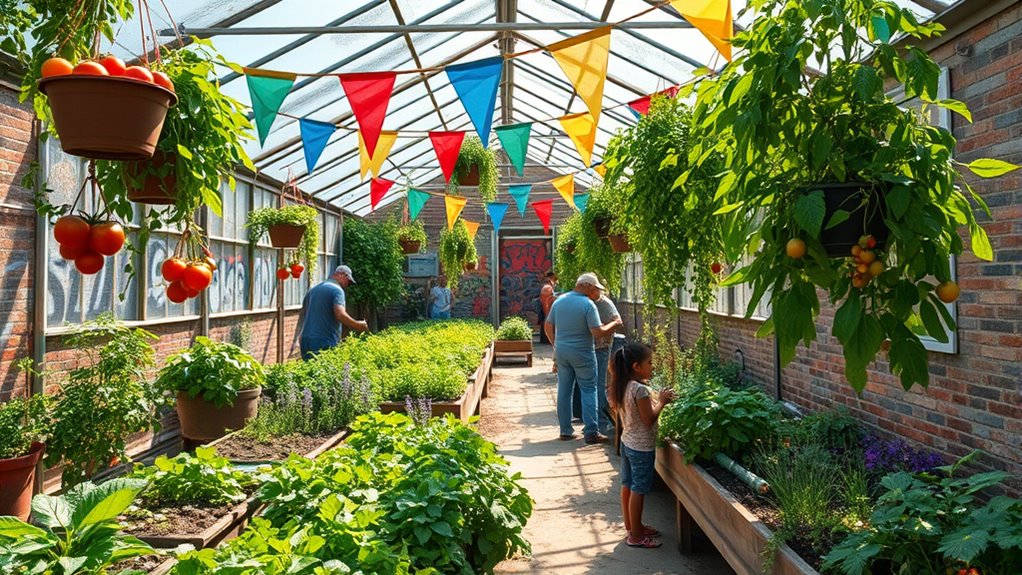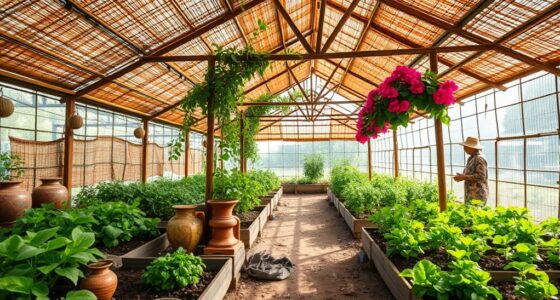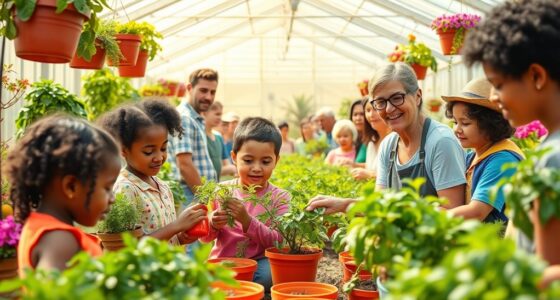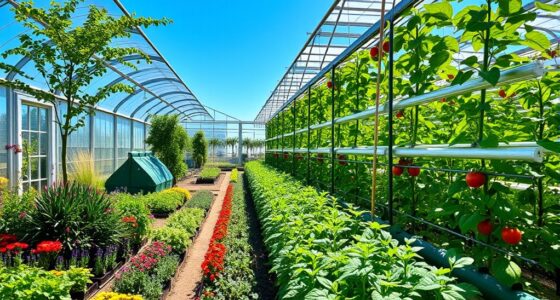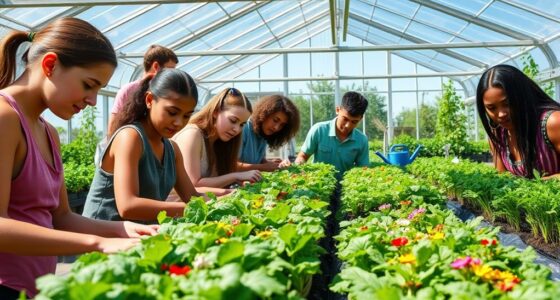Community greenhouses are transforming food deserts into vibrant green spaces by providing fresh, healthy produce directly within neighborhoods. They enable residents to grow fruits, vegetables, and herbs year-round, even in harsh weather. These greenhouses promote sustainable urban farming practices and involve local people through educational programs. By turning vacant lots into productive spaces, they improve access to nutritious food and foster community action. Keep exploring to discover how these green oases make a lasting difference.
Key Takeaways
- Community greenhouses transform food deserts into green spaces by providing accessible, fresh produce year-round within urban neighborhoods.
- They promote sustainable farming practices like composting and water conservation, supporting environmental health.
- Greenhouses serve as educational hubs, empowering residents with urban farming skills and encouraging local food production.
- Innovative designs such as vertical farming maximize space, converting vacant lots into productive food-growing environments.
- By reducing transportation needs and fostering community involvement, greenhouses improve food access and promote neighborhood resilience.

In many neighborhoods, access to fresh, healthy food remains a persistent challenge, creating what are known as food deserts. These areas often lack grocery stores that carry nutritious options, leaving residents to rely on processed foods that can harm their health. Community greenhouses are emerging as a practical solution, transforming these food deserts into vibrant green oases. By utilizing urban farming techniques within greenhouses, communities can grow fresh produce right where people live, reducing the need for long trips to distant stores. This approach promotes sustainable agriculture, which emphasizes environmentally friendly practices that conserve resources and support local ecosystems. When you participate in or support community greenhouses, you’re helping to create a more resilient food system that benefits both people and the planet.
Community greenhouses serve as accessible hubs where individuals can learn about urban farming and sustainable agriculture practices. These controlled environments allow for year-round cultivation, regardless of outside weather conditions. As a result, you can enjoy fresh vegetables, herbs, and fruits even during harsh winters. The focus on urban farming means that these greenhouses are often situated within city neighborhoods, making healthy food more readily available to residents who might otherwise face barriers like transportation or cost. When you buy or grow your own produce in these greenhouses, you’re directly contributing to the local economy and reducing the carbon footprint associated with food transportation.
Sustainable agriculture within community greenhouses emphasizes minimal waste, water conservation, and organic growing methods. These practices ensure that the food produced is healthy and environmentally responsible. You might find that community members participate in composting, rainwater harvesting, and organic pest management—techniques that preserve the land for future generations. By supporting such initiatives, you help foster a sense of community and shared responsibility for food security. Importantly, these greenhouses often offer educational programs, empowering residents to develop their own urban farming skills. This knowledge can inspire others to start their own small-scale food projects, expanding the reach of sustainable agriculture far beyond the greenhouse walls.
Additionally, incorporating innovative greenhouse design, such as vertical farming or hydroponics, can maximize space and productivity in limited urban areas. In essence, community greenhouses are more than simple food sources—they’re catalysts for change. They turn vacant lots and neglected spaces into productive, green environments that nourish both bodies and communities. By promoting urban farming and sustainable agriculture, these greenhouses help bridge gaps in food access, making fresh, healthy options available to everyone. When you get involved, whether through volunteering, donations, or simply spreading awareness, you’re helping to create a healthier, more equitable future where food deserts are replaced by green oases of opportunity and growth.
Frequently Asked Questions
How Do Community Greenhouses Fund Their Operations Long-Term?
You can sustain community greenhouses long-term through diverse funding sources. Grant funding provides essential financial support, especially for startup costs and expansion. Building strong community partnerships also plays a crucial role, as they can offer ongoing sponsorship, donations, or volunteer help. By combining grant applications with active community engagement, you guarantee the greenhouse remains financially stable and continues to serve local food needs effectively.
What Challenges Do Greenhouses Face in Urban Environments?
You face urban pests and space limitations that challenge your greenhouse efforts. While city environments offer accessibility and community support, pests like insects and rodents threaten your crops. Limited space restricts your planting options, making efficient use of every square foot essential. Balancing pest control with space management demands innovative solutions, but overcoming these hurdles can transform your urban greenhouse into a thriving oasis, bringing fresh food and green vitality to the community.
How Do Greenhouses Impact Local Economies Beyond Food Access?
Greenhouses boost your local economy by creating urban employment opportunities, from horticulture jobs to maintenance roles. They also foster local entrepreneurship, inspiring small-scale farmers and vendors to sell fresh produce directly to your community. As greenhouses thrive, they attract visitors, increasing foot traffic and supporting nearby businesses. This cycle helps you experience a more vibrant, resilient economy while enjoying access to fresh, locally-grown food.
Are There Specific Crops That Thrive Better in These Greenhouses?
You’ll find that specific crop varieties thrive better in community greenhouses because of tailored growing conditions. Herbs like basil and mint, leafy greens such as lettuce and spinach, and tomatoes often flourish due to controlled temperatures and humidity. These greenhouses optimize growing conditions, allowing you to grow a diverse range of crops year-round. Choosing the right crop varieties guarantees a successful harvest and maximizes the benefits of your greenhouse space.
How Do Greenhouses Ensure Inclusivity for Diverse Community Members?
You can promote cultural inclusivity and language accessibility by designing greenhouses that celebrate diverse traditions and providing multilingual signage and resources. Engage community members through inclusive workshops, ensuring everyone feels welcome and valued. By actively listening to different cultural needs and adapting practices accordingly, you create a space where all community members can participate, learn, and share, making greenhouses truly accessible and representative of the diverse populations they serve.
Conclusion
Think of community greenhouses as secret gardens, transforming barren deserts into lush oases where hope and nourishment flourish. By nurturing these green sanctuaries, you help turn a lifeless landscape into a vibrant haven, offering fresh food and renewed community spirit. Every plant grown is like a drop of water in a parched land, reviving it from within. Together, you become the gardener of change, cultivating a future where everyone can thrive amid the greenery.
